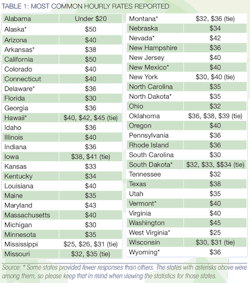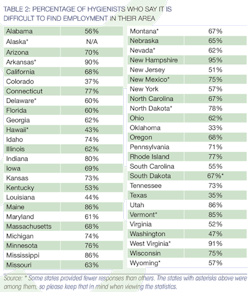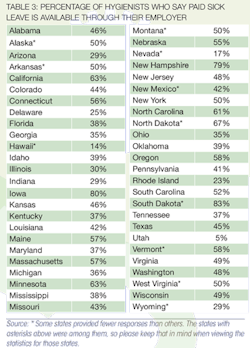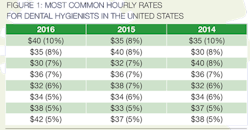By Mark Hartley, Editor, RDH
Salary surveys in recent years have promoted many comments from dental hygienists, such as "too many dental hygiene programs" or "the dental hygiene market is saturated." The combination of the recession and economic forecasts about plentiful jobs in the dental hygiene profession have led many in the profession to question the availability of jobs, as well as the impact on salaries and benefits if jobs are not available.
For the last three years, the surveys have asked dental hygienists about their perceptions on how hard it is to find employment. In 2014, 86% said it was difficult to find work. In 2015, the percentage slipped to 78%. For the recent 2016 survey, 63% said it is difficult. While 63% is arguably still too many hygienists who have a nervous perception about finding work in their careers, the decrease since 2014 indicates that dental hygienists are feeling better about job prospects.
Naturally, the proximity of multiple dental hygiene schools influences a dental hygienist's perceptions about the market.
The states with the highest levels of insecurity about the job market were Indiana (80%), Connecticut (77%), Minnesota (76%), Wisconsin (75%), and Michigan (74%). Less concern about finding employment was noted in Texas (35%), Colorado (37%), Louisiana (44%), Washington state (47%), New Jersey (51%), and Virginia (52%).
An Indianapolis veteran hygienist said, "Too many grads and not enough good jobs. The doctors know we are at a surplus and take advantage of that with low pay and no benefits. My doctor does not even pay us on the due date-it is sometimes up to six days later. But no one cares, there is no one for accountability, and if we say anything we get fired."
As implied above, Texas is not immune to an overcrowded job market. One hygienist noted, "My salary has gone down since 2013 by more than $3 an hour. I was earning $42 an hour until 2013. Now most jobs offer only $37 an hour. The Dallas-Fort Worth area has seen an influx of new graduates who will work for less than $32 an hour. This brings the wages down for everyone."
RDH eVillage conducted the 2016 survey last fall, and the electronic newsletter published several articles about the results, which involved 2,543 dental hygienists. The series of articles appearing in RDH eVillage focused on job benefits, hourly rates, and annual income. (Although some of the information in the articles is discussed below, readers can view all of the statistics by going to DentistryIQ.com and searching "2016 salary survey.")
Salaries
The survey pinpointed that 10% of American dental hygienists earn $40 an hour, which was the most common hourly rate reported in 2015 also. The most common hourly rates for the last three years suggest that not much has changed in dental hygiene compensation (see Figure 1).
The lack of pay raises remains one reason why. Only 27% of dental hygienists reported receiving a pay raise within 12 months of completing the survey. Other responses to a question about pay raises included:
• 23% last received a raise one to two years ago.
• 18% last received a raise three to five years ago.
• 20% last received a raise more than five years ago.
A Virginia dental hygienist said, "I believe salaries have not improved much, especially considering that some dentists have actually increased the number of patients on the daily schedule. There are also more dentists hiring temporarily through employment agencies, hence temporary hygienists are more likely to be shortchanged while still carrying the same work load as regular hygienists, if not more."
Increased workloads were mentioned several times in comments from readers. A Michigan hygienist said, "Sixteen years ago, I was making $6 more per hour, plus commission. Now, I'm responsible for my job duties and scheduling/filling any cancellations for the next day. I rarely get to leave within two hours of dismissing my last patient. My boss says there are plenty of people who want my job, so take it or leave it."
Benefits
The availability of employee benefits within the dental hygiene profession also has not changed much within the last three years.
Among full-time dental hygienists, the fringe benefits of paid holidays and vacation remain fairly common. However, there were only four benefits (CE tuition reimbursement, health insurance, paid sick leave, retirement plan, and uniforms) available to more than 50% of full-time dental hygiene employees.
"Unfortunately, the hygiene schools have flooded the market and dentists are taking advantage of this," a Maine dental hygienist said. "Many of the new hygienists are shocked at not being able to find a job and were told in school that many jobs were available. Schools have a duty to fill classrooms and keep their businesses going, but they should not misguide these students into thinking that they will be employed with a full range of benefits. Yes, many hygienists are retiring, but when the employer hires a new hygienist this position becomes low paying and without benefits."
The RDH eVillage survey asked dental hygienists if an employee benefit was available to them at their place of employment, regardless of whether they enrolled or utilized the benefit.
The U.S. Bureau of Labor Statistics (BLS) updated its statistics for American workers' access to health insurance, retirement, and life insurance benefits in March 2016. Several comparisons can be made with the dental hygiene profession.
Retirement benefits
• 88% of registered nurses have access to retirement benefits; only 67% of full-time dental hygienists do.
• Among American civilian workers, 80% who work full time have retirement benefits; 37% of part-time workers have access to the benefit. As mentioned above, 67% of full-time dental hygienists have retirement benefits, but 48% of part-timers have retirement benefits-higher than the national average.
• However, many dental hygienists still work for companies with fewer than 49 employees. Only 48% of American workers in smaller businesses have access to retirement benefits.
Health insurance
• 88% of registered nurses have access to health insurance compared to 53% of full-time dental hygienists.
• Among American private industry workers, 86% of full-time employees and 19% of part-time employees have access to health insurance. Again, part-time hygienists fared better overall, with 27% reporting the availability of health insurance.
• Smaller private businesses in the United States (under 49 employees) make health insurance available to 52% of workers.
Life insurance
• 7% of registered nurses have access to life insurance benefits. Only 23% of full-time dental hygienists do.
• Among American private industry workers, 71% of full-time employees and 12% of part-time employees have access to life insurance. Of the three benefits covered by the BLS update, dental hygiene lags behind with 23% for full-timers and 8% for part-timers.
• Even in a comparison with smaller businesses of fewer than 49 employees, 35% of American workers have access to life insurance.
A Nevada dental hygienist said, "The hygienists in my office saw two 5% pay cuts, loss of the profit sharing plan, and loss of health insurance at no charge in 2008 and 2009. This month, we lost office-provided and laundered uniforms, as well as a week of our paid vacation time."
Growth of market
For much of the last decade, economic forecasts centered on dental hygiene as being one of the best occupations for earning excellent pay with minimal training. In addition, the profession is consistently projected as being one of the fastest growing occupations during the post-recession years, with a glowing outlook going well into the next decade and beyond.
Are dental hygiene salaries keeping pace with the rosy projections?
The survey asked dental hygienists to estimate what they would earn during 2016. Among U.S. dental hygienists who indicated that they work full time, 978 said they expected to finish the year earning up to $70,000. Only 341 full-time dental hygienists expected to earn more than $70,000.
In contrast, the U.S. Bureau of Labor Statistics said the median annual pay for dental hygienists in 2015 was $72,330. U.S. News & World Report, which claims dental hygiene is the top "health care support job," cited $71,520 as the median annual salary.
Based on the RDH eVillage survey, the median salary for full-time dental hygienists falls in the $51,000 to $60,000 income bracket, easily $10,000 less than what employment outlooks advocate.
Millennials
Younger dental hygienists were often lured into a dental hygiene career by the siren call of the forecasts mentioned above, which predicted plentiful jobs in the profession. Many received their dental hygiene training during the Great Recession, and a smattering of available part-time jobs didn't increase confidence among new graduates about paying off student loans.
The oldest millennials, by the way, turned 35 in 2016. So they most definitely have a significant voice in the dental hygiene profession; in fact, 26% of the respondents to the RDH eVillage salary survey were millennials.
Here are some comparisons between millennials and the rest of the profession:
• Millennials: 65% work more than 30 hours a week.
• Everyone else: 49% work more than 30 hours a week.
• Millennials: 59% view finding employment as a dental hygienist as being "difficult" in their area.
• Everyone else: 64% view finding employment as a dental hygienist as being "difficult" in their area.
• Millennials: 44% receive paid sick leave.
• Everyone else: 46% receive paid sick leave.
• Millennials: 46% have access to health insurance through their employer.
• Everyone else: 39% have access to health insurance through their employer.
• Millennials: 50% say they practice in metropolitan areas.
• Everyone else: 57% practice in metropolitan areas.
• Millennials: 44% anticipated earning between $41,000 and $60,000 as a dental hygienist during 2016.
• Everyone else: 38% anticipated earning between $41,000 and $60,000 as a dental hygienist during 2016.(The income range above was the most common range for dental hygienists reported in the salary survey.)
• Millennials: Nationally, the most common hourly rates were $35 (11%), $40 (9%), $30 (8%), $32 (8%), and $36 (6%).
• Everyone else: Nationally, the most common hourly rates were $40 (10%), $35 (7%), $36 (7%), $30 (6%), $32 (6%), and $38 (5%).
• Millennials: 38% received a pay raise within the last year.
• Everyone else: 24% received a pay raise within the last year.
"It is somewhat easier to get a job. It used to be terrible," one millennial hygienist said.
Finally, a millennial based in Atlanta wrote something that many veteran hygienists have said for years. "After I worked at one office for one year, I asked for a raise. I also asked for a raise after working for another office for five years. Both offices refused, saying that I get paid what the other hygienists in the area get paid. I learned that was not true after talking about salaries with other hygienists. I believe new graduates get paid less but with commission we are working harder with shorter times for patients." RDH











